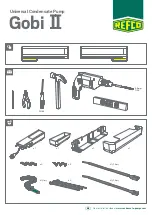
Electrical Maintenance
8-11
Testing the Flywheel (RPM) Sensor:
The following equipment is required:
• AC voltmeter capable of reading up to 10 volts
• Ohmmeter
The flywheel sensor may be checked as follows:
1. Position the flywheel so a ring gear tooth is in the center of the sensor mount hole.
2. Turn the flywheel sensor into the starter mounting flange until it contacts the ring gear. Back out the sensor 1/4 turn and
tighten the locknut.
Flywheel (RPM) Sensor
3. Disconnect the FS1 and FS2 wires from the sensor.
Flywheel (RPM) Sensor Wires
4. Run the unit on low speed and high speed. Check the AC voltage output across the sensor terminals. Note: Use a good quality
meter able to read low AC Voltage values (1 to 2 vac). Check the AC voltage output across the sensor terminals. Use a meter
with a high ohms per volt internal resistance. Note: An automotive type meter may not give an accurate reading because the
meter may load the circuit heavily and cause the voltage level to appear lower
than it actually is.
a. The output voltage should be 1.0 to 2.0 Vac on low speed.
b.The output voltage should be 2.0 to 2.5 Vac on high speed.
NOTE: If the voltage is slightly off, the voltage may be increased by turning the sensor in more, and the voltage may be
lowered by turning the sensor out more.
5. Reconnect the FS1 and FS2 wires to the sensor.
If the flywheel sensor passes the above test, the sensor may be considered good.
If the engine will not start, an alternate less reliable test may be performed as follows:
Disconnect the sensor from all wires, and measure the resistance across the terminals and from each terminal to the aluminum
case. The resistance should be 250 to 300 ohms across the terminals, and there should be no continuity from each terminal to the
case.
GLOW PLUGS
Glow plugs heat the combustion chamber to aid in quick starting. The glow plugs are energized when the microprocessor
initiates unit starT-up. A defective glow plug (burned out) can be detected by placing a clamp-on ammeter on the H wire to the
glow plugs. Normal current draw during preheat is approximately 11 to 13 amps. A current draw in this range means all three
glow plugs are working. If the current draw during preheat is less than this, at least one glow plug is bad.
To isolate an open circuit glow plug, remove the wires and test each glow plug individually with an ohmmeter or a jumper
wire and ammeter. Each glow plug should have a resistance of 2.3 ohms. The current draw for each glow plug should be
approximately 4.3 amps.
Summary of Contents for T-1000R
Page 14: ...Safety Precautions 2 6 Warning Decals 2e24151g0 ...
Page 34: ...Maintenance Inspection Schedule 4 10 ...
Page 57: ...Unit Description 5 23 Purge Mode UT Series 1 3 4 5 2 ...
Page 67: ...Unit Description 5 33 Zone 1 Cool and Zone 2 Cool UT SPECTRUM Units ...
Page 69: ...Unit Description 5 35 Purge Mode UT SPECTRUM Units ...
Page 71: ...Unit Description 5 37 Zone 1 Cool and Zone 2 Heat UT SPECTRUM Units ...
Page 72: ...Unit Description 5 38 ...
Page 74: ...Diesel Electric Menu 6 28 Adjust Brightness 6 29 Time 6 30 ...
Page 120: ...Operating Instructions Standard HMI 7 18 ...
Page 152: ...Engine Maintenance 9 14 T Series Fuel and Oil System Components TK 376 ...
Page 154: ...Engine Maintenance 9 16 T Series Fuel and Oil System Components TK 270 ...
Page 156: ...Engine Maintenance 9 18 UT Series Fuel System Components AMA768 ...
Page 172: ...Engine Maintenance 9 34 T Series Engine Mounting Components for 2 Cylinder Engine ...
Page 184: ...Engine Maintenance 9 46 ...
Page 238: ...Refrigeration Maintenance 10 54 ...
Page 246: ...Clutch Maintenance 11 8 ...
Page 258: ...Structural Maintenance 12 12 ...
Page 264: ...Mechanical Diagnosis 13 6 ...
Page 265: ...14 Electric Standby Diagnosis ...
Page 268: ...Electric Standby Diagnosis 14 4 ...
Page 269: ...15 Refrigeration System Diagnosis ...
Page 272: ...Refrigeration System Diagnosis 15 4 ...
Page 280: ...Remote Evaporators 16 8 ...
















































